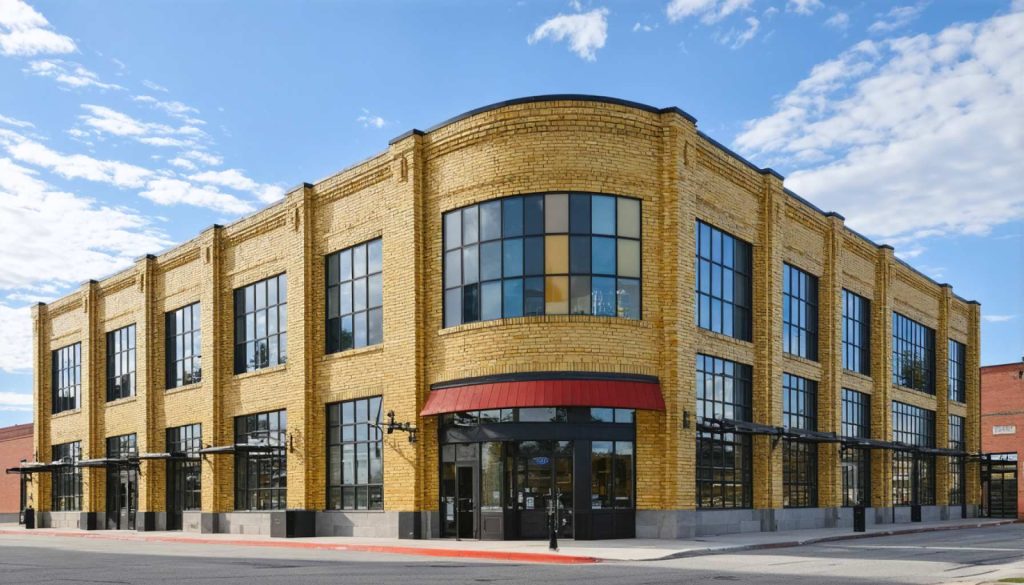
- The Black River Innovation Campus (BRIC) is revitalizing Springfield, Vermont, by fostering tech entrepreneurship and economic growth.
- A $7.2 million renovation of the historic Park Street schoolhouse will create a modern hub for innovation, including 23 market-rate apartments by 2024.
- BRIC offers innovative programs like the Actuator and partners with Google for tech certification courses in e-marketing and cybersecurity.
- BRIC is committed to nurturing new talent through youth-focused STEM programs and outreach in nearby towns, like Randolph, with the Cultivator initiative.
- Despite challenges like high construction costs, BRIC is dedicated to integrating social impact and community values into business and innovation.
- Springfield’s transformation showcases how Vermont, though small, can foster a vibrant ecosystem of collaboration and vision.
Beneath the shadow of Vermont’s Green Mountains, a renaissance is taking shape in Springfield. At the heart of this transformation is the Black River Innovation Campus (BRIC), a nonprofit committed to nurturing tech entrepreneurship and revitalizing the local economy. With ambitious plans and community-first ideals, BRIC is infusing new life into the historic Park Street schoolhouse, originally constructed in 1895.
A journey through the halls of this venerable building reveals much about BRIC’s mission. The schoolhouse’s timeworn woodwork and grand central staircase are not just relics of the past; they are the backbone of a structure being updated to serve as a 21st-century launchpad for innovation. By 2024, the $7.2 million renovation will have rejuvenated the school into a dynamic ecosystem where businesses can blossom and people can find a home—literally and figuratively.
Once complete, the building won’t just be a monument to history. Plans include transforming unused space into 23 market-rate apartments. The hope is to create a seamless environment where entrepreneurs live, work, and thrive in close quarters. Yet, Executive Director Vin Fusca acknowledges a challenge: Vermont’s high construction costs hinder developers from investing in projects like these. Despite this, the determination remains palpable as funding continues to be a focus.
Springfield’s rebirth is fueled by BRIC’s innovative programs, including the Actuator, an intensive, eight-week curriculum designed to arm budding tech entrepreneurs with the knowledge and skills needed in today’s fast-paced market. The curriculum covers a range of fields from game development to food manufacturing. Participants are drawn not only from Vermont but from as far as Boston and New York, eager to cultivate ideas in this fertile setting.
Underscoring its commitment to the digital future, BRIC has partnered with Google to offer certification programs in crucial tech domains like e-marketing and cybersecurity. With these efforts, BRIC doesn’t just aim to create jobs; it strives to foster an ecosystem that integrates social impact into business, aligning perfectly with Vermont’s community-focused values. This small state is proving that size is no barrier to fostering innovation and generosity, where networks are robust and resources, though limited, are strategically oriented to spark collaboration.
Beyond adult innovation, BRIC is seeding the STEM future through youth programs, with Lego Robotics kits and STEAM summer camps sparking young imaginations. Last year’s pilot camp was a resounding success, filling all slots in a mere three days. This year, ten camps are set to launch, inviting students of all ages into the wonderous world of coding and engineering.
Expanding beyond Springfield, BRIC’s impact stretches to the town of Randolph through its Cultivator program. Designed as a satellite initiative, it offers entrepreneurship training and co-working spaces for ambitious minds—proof that BRIC perceives no boundary in its quest to foster economic development.
If Vermont once seemed a quiet cul-de-sac in the rush of the modern economy, BRIC’s work challenges that notion. It invites anyone eager to partake in its collaborative, vibrant ecosystem to step forward. Small but mighty, Vermont has its arms wide open for bold visionaries ready to write the next chapter of innovation. With its harmonious blend of tradition and modernization, BRIC stands as a testament to what can be achieved when vision meets community spirit.
As the Park Street schoolhouse evolves, it embodies more than an architectural project. It signifies a resurgence—a spirited dedication to building a resilient economic landscape. Springfield, enriched by BRIC’s energy and the talented individuals it attracts, is poised to be the bright thread in Vermont’s economic tapestry.
Inside Vermont’s Renaissance: How Springfield is Becoming a Hub for Tech Innovation
Introduction
In the picturesque surroundings of Vermont’s Green Mountains, Springfield is experiencing a dynamic transformation. This revival, spearheaded by the Black River Innovation Campus (BRIC), is turning the town into a beacon of tech innovation and community revitalization. This article delves deeper into BRIC’s ambitious projects, examining their implications, challenges, and future prospects.
BRIC’s Mission and Its Impact
BRIC’s mission goes beyond mere economic development; it aims to create a sustainable tech ecosystem that aligns with Vermont’s community-focused values. By rejuvenating the historic Park Street schoolhouse into a modern innovation hub, BRIC is merging the traditional with the contemporary. The $7.2 million renovation project is both a nod to Springfield’s heritage and a strategic move to attract tech talent.
A Haven for Entrepreneurs
One of BRIC’s standout offerings is its entrepreneurship programs, such as the Actuator. This eight-week intensive training helps tech startups navigate the complexities of entrepreneurship. Offering expertise in fields like game development and food manufacturing, it draws participants from Vermont to major cities like Boston and New York, showcasing the allure of Springfield as a nurturing ground for innovation.
Google Partnership and Expanded Curriculum
In partnership with Google, BRIC provides certifications in cutting-edge tech domains like e-marketing and cybersecurity. These programs are crucial, as they equip participants with skills in high demand in today’s job market. Such initiatives demonstrate BRIC’s commitment to not just job creation, but to crafting an ecosystem that encourages social impact and digital literacy.
Nurturing Young Minds
Beyond adult-focused programs, BRIC is actively investing in the future through youth STEM initiatives. With ten Lego Robotics and STEAM summer camps planned, BRIC is inspiring the next generation early. These camps not only encourage creativity and critical thinking among young learners but also position Vermont as a state invested in children’s educational growth.
Overcoming Challenges
Despite BRIC’s promising endeavors, challenges remain. High construction costs in Vermont are a significant obstacle that could impede similar projects. However, Executive Director Vin Fusca emphasizes that securing funding and strategic resource allocation remain priority areas to ensure continued growth.
Regional Expansion
BRIC’s influence extends beyond Springfield to towns like Randolph, with satellite programs like the Cultivator providing co-working spaces and entrepreneurial training. This expansion is pivotal, broadening the reach and impact of BRIC’s programs, and weaving stronger connections throughout the region.
Future Prospects and Recommendations
BRIC stands as a model of how small communities can become innovation powerhouses. For regions looking to replicate this success, here are a few tips:
– Foster Partnerships: Collaborations with tech giants like Google broaden the scope and credibility of programs, making them more attractive to a wider audience.
– Invest in Youth: By focusing on STEM education for younger populations, communities ensure long-term growth and interest in tech fields.
– Preserve Heritage While Innovating: BRIC’s use of the Park Street schoolhouse shows the value of blending historic preservation with modern updates.
– Create Integrated Living Spaces: By offering living quarters alongside workspaces, communities can attract and retain top talent.
For more information on how such transformations are possible in smaller communities, visit BRIC.
Conclusion
Springfield’s renaissance is a testament to the power of vision, partnership, and community spirit. Under BRIC’s guidance, this small town is defying the odds, proving that Vermont’s Green Mountains can cradle innovation just as effectively as Silicon Valley. Through its transformative efforts, BRIC is scripting a promising chapter for Springfield and beyond, one filled with potential and community-driven growth.



